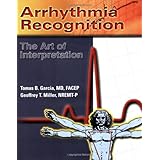
Average Reviews:

(More customer reviews)Arrhythmia recognition is the toughest part of EKG interpretation. Most books that teach it do so by illustrating each arrhythmia with a strip or two, usually using ideal examples. This approach leaves the reader ill prepared to recognize the variations that crop up in practice. The philosophy of this book is "you can't really know an arrhythmia unless you see it over and over".
This book covers all the atrial and ventricular arrhythmias. Each brief but thorough chapter concisely explains the electrophysiology of the abnormal rhythm, well illustrated by copious full color graphics, and ends with a series of analyzed strips and EKGs that show the arrythmia in all its possible presentations. As an example, I've always had a problem with recognizing atrial flutter at 2:1 conduction (anybody can recognize the 'saw tooth' pattern at higher ratios). After reading the chapter on the subject, I had it down cold.
There are also quizzes and practice EKGs to drive home the skill, and the book has a corresponding Web site with further resources. Highly recommended.
Click Here to see more reviews about: Arrhythmia Recognition: The Art Of Interpretation
2004 AJN BOOK OF THE YEAR AWARD WINNER!An American Journal Of Nursing 2004 Book Of The Year!Arrhythmia Recognition: The Art Of Interpretation Uses Hundreds Of Four-Color Graphics To Communicate The Complex Topics Related To Arrhythmia Recognition.The Text Focuses On The Pathophysiological Mechanisms Involved In The Formation And Maintenance Of Complex Arrhythmias And On Their Clinical Recognition.Each Rhythm Strip Provides A Descriptive Table Outlining The Various Abnormalities In A Logical, Easy-To-Follow Sequence.In Addition, There Are Analytical Narratives Outlining What Providers Should Consider When Approaching The Strip.The Tables And Analytical Narratives Are Intended To Formulate Functional Interpretative Skills To Consider When Approaching A Complex Arrhythmia In A Clinical Situation.
Click here for more information about Arrhythmia Recognition: The Art Of Interpretation

0 comments:
Post a Comment